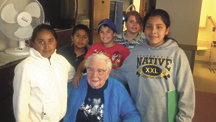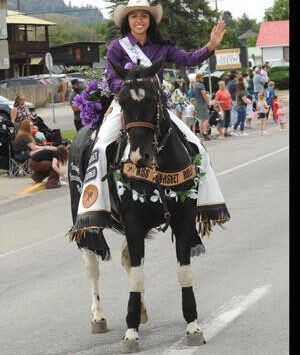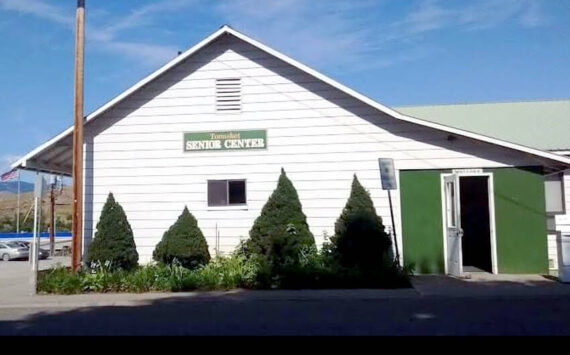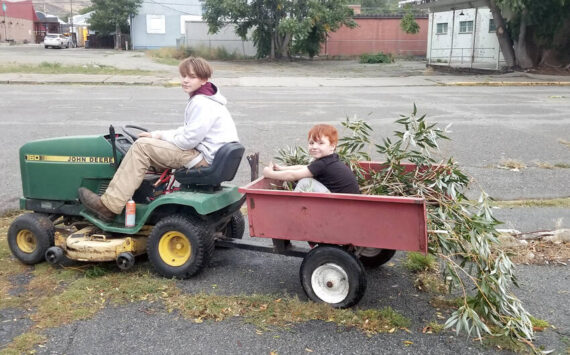
Members of Tonasket Elementary fourth grade teacher Scott Olson’s class, including (l-r) Ruby Capote, Kevin Garcia, Enrique Long-Sandoval, Kyndall Rollins and Christina Torres, visited 105-year-old Lula Gardner to learn about what school was like 100 years ago.
105-years-old, shares school memories with TES 4th graders
- TONASKET – The more things change, the more they seem to stay the same.
- Though the world is a dramatically different place than it was 100 years ago, five students in Scott Olson’s fourth grade class found that the experience of attending school is in many ways similar to what it was in 1912.
- And they got to find that out from someone who was there at the time as they paid a visit to 105-year-old Lula Gardner, who was a first grader at Horse Spring Coulee’s “Bungalow School” a century ago and attended there through the eighth grade.
- The visit was part of Olson’s ongoing project with his classes to collect stories and information about the 30 or so schools that eventually were consolidated into the far-flung Tonasket School District.
- “In collecting the history of these schools, we can tie it into the idea of, why do people move?” Olson said. “So many schools study the Oregon Trail. But we don’t have to study the Willamette Valley. We can look at our neighbors and the stories that are right here. That’s why we go back and ask them questions, see the connections. It brings history alive. It makes it real people and real places. With that nice mural of the different schools (in the Tonasket Elementary School lobby), it made it a natural thing to do.”
- While visiting Mrs. Gardner, the kids – Enrique Long-Sandoval, Kevin Garcia, Kyndall Rollins, Ruby Capote and Christina Torres – took turns asking questions about what it was like to go to school in a one room school house up in the coulee.
- Mrs. Gardener said her family migrated from North Carolina to the Dayton area — then in the Oregon Territory — sometime in the 19th century, then packed up a wagon and settled in the Sinlahekin in 1891. They lived in a number of locations in the area before settling down in Horse Spring Coulee.
- One thing that was different in those days was just the task of getting to school.
- “I got to school on my own two feet,” Mrs. Gardner said. “It was only a quarter mile. We even got outside the yard gate, got on a sled and rode it clear down to school from where I lived. The worst part was you had to drag that sled back at night.
- “My brother built a bobsled. All the kids would sit on the plank, six or eight of them would sit on the plank and ride down to the schoolhouse. We used to start by pulling the sled up to the pines, probably another quarter mile, and ride down through the barnyard, around a couple of turns, up the hill a bit and over to the schoolhouse. But just think, you’d have to pull that thing a half mile back uphill again after school.”
- For most kids, the lack of mobility that we take for granted today meant school ended after eighth grade, since getting to the high school meant traveling all the way into town.
- “There was just no way to get in to the high school every day,” Mrs. Gardner said. “A few years later I got married, and who wants to go to high school then?”
- As for what they studied in school, Mrs. Gardner said they received a steady diet of “Reading, writing and ‘rithemetic, with some geography and history.
- “We had two big blackboards that went the full length of the walls. We used both those and paper.”
- When asked if they used story problems while learning math, she said, “No, we just did basic facts, over and over. And we did all our work at the schoolhouse unless we had a problem with something.”
- Discipline wasn’t all that different: it usually involved missing recess, as valued by elementary students 100 years ago as it is today.
- “If we got in trouble we’d have to stand in the corner and stay in for recess,” Mrs. Gardner said. “I don’t remember anyone getting a whipping, though.
- “They had to shape me up every once in awhile. But I was pretty good.”
- Other staples of school life that have survived into the modern era were traditions surrounding the last day of school.
- “We had picnics, and the kids and teachers and parents would all be there,” Mrs. Gardner said. “There was a brush patch in the pasture and we’d play games, run races, play ball and have sack races. There would be salads, sandwiches, cake and we’d make ice cream.”
- And of course there were still special programs around the holidays.
- “We did some programs where we got up and recited things, and did little plays,” Mrs. Gardner said. “Every now and then we had a spelling be, but who really wants to remember that?”
- After meeting with Mrs. Gardner, the group took a drive up Horse Spring Coulee Road to attempt to locate the site of the school, which was torn down long ago. GPS coordinates of the spot weren’t enough to overcome a drenching rain and high grass that likely obscured the location of the remaining foundation.
- Olson and his students agreed that despite some of the differences that were fun to hear about, a lot about school at that time was similar to today.
- “Recess was a favorite thing then and now,” Olson said. “Getting to school was different, but the experience while there was very much the same.
- “People coming out west just wanted to make their lives better. We could very well have been them.”
- See related article: Lula Lenora Burbery-Gardner




